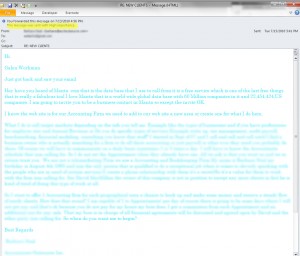Write Like Walt Disney
I am not a prude. I am not a prude. I am not a prude. But, …
Language standards today allow for four-letter swear words on news reports, and Congressional hearings feature six-letter scatological adjectives. But, …
If you’re writing a newsletter, web site, or blog with the intention of attracting clients, you still have to keep the language g-rated Disney clean.
I’ve struggled with my Puritanism as I’ve read blogs that have used street language for a service whose main clients are street-wise people. Doesn’t the author’s word choice show that the blogger is in touch with the client’s culture? Isn’t he legitimately reflecting the scenes he’s writing about?
I’ve struggled with my Puritanism as I’ve giggled over parody song lyrics that dive to the raunchy side. Aren’t the f-bombs part of the shock value of the humor?
The simple answer is, no. In marketing and sales, there no upside to alienating a single person with your language.
When you are trying to capture new business or to reach a new audience, the best words to use are those which are not going to be off-putting to any potential client. Moreover, you want to write using language that isn’t going to get your message blocked by any corporate word filter program (and, there are programs out there that are fussier than any old-fashioned schoolmarm!)
Think like the Wall Street Journal. Last week they reported:
… that Timberwolf was one s— deal,” Thomas Montag, who helped run Goldman’s securities business, wrote in a June 2007 email that was repeatedly referred to at the hearing.
See the full article, including information on language filters.
The message of corporate callousness was communicated. Unambiguously. Without the WSJ itself sounding like a low-life cad.
In the WSJ example, the writers were confronting a situation where the original information they were reporting on itself contained vulgar language. A Federal appeals court has said that a ban on fleeting instances of expletives by the FCC is unconstitutional, so the paper could have certainly argued that it needed to print the full six-letter adjective.
But, the Journal choose to communicate without offending. There was no external Post Office standards they were worried, about. Nonetheless, they chose to print the quotation without printing quite every character. The Jounal‘s decision was a wise decision, I think. No public library is going to cancel its subscription because of indecent content. No old fogy is going to stop his subscription, either.
On the other hand, too often gratuitous swearing simply cuts down on the reach of the message. One group’s whose singing talent and political humor I like is The Kinsey Sicks. They do a very fun and very raunchy adult cabaret show. Some of their songs are irredeemably obscene because of the sexual nature of the topic. But, none of their songs I heard at their show can be played on AM radio. In the middle of every political or social commentary, one of the crew for yuks shouts out a George Carlin no-no word. Sigh. The Kinsey Sicks will always have a limited audience.
No, I am not a prude. In fact, I doubt that I could be on live radio or TV very long before my speech patterns of an ex-police dispatcher betray me. I don’t judge people negatively because they use, ugh…., colorful language.
But, some people will think you’re uncouth if you use swear words. Some people will wonder about your business judgment if you use that kind of language in public.
And, you want both ex-police dispatchers and current schoolmarms to read your marketing material and to become your client.

